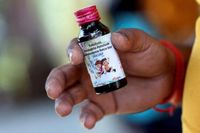It has been a harrowing autumn for families in central India. Since September 2025, at least 22 children across the states of Madhya Pradesh and Rajasthan have died after consuming Coldrif, a cough syrup later found to be contaminated with diethylene glycol (DEG) at levels nearly 500 times the permissible limit. The tragedy, which has unfolded over mere weeks, has reignited fierce debate about India’s pharmaceutical oversight and the country’s role as a global drug supplier.
According to Reuters, the U.S. Food and Drug Administration (FDA) confirmed on October 10, 2025, that these toxic syrups had not been shipped to the United States. The FDA stated it was aware of “devastating, ongoing diethylene glycol and ethylene glycol contamination in children’s cough and cold medicine in India” and emphasized its vigilance in preventing such contaminated drugs from entering the U.S. market. Indian authorities assured the FDA that these products were not exported from India to any other country.
But for families in India, the damage had already been done. The deaths were all linked to the Coldrif brand, produced by Tamil Nadu-based Sresan Pharmaceuticals. As reported by The Straits Times, the most recent fatalities occurred on October 8, when two children from Madhya Pradesh’s Chhindwara district died while being treated in Nagpur, Maharashtra. Coldrif was found to contain 48.6% DEG, a compound commonly used in antifreeze and brake fluids but lethal in even small quantities when ingested. The permissible limit for DEG in pharmaceutical products is a mere 0.1%—making the contamination in Coldrif not just a regulatory lapse, but a catastrophic failure.
The World Health Organization (WHO) has not minced words. It described a “regulatory gap” in India’s oversight of locally sold syrup medicines and warned that contaminated products could reach other countries through unregulated distribution channels. The WHO is closely monitoring media reports of pediatric illnesses and deaths in Madhya Pradesh and Rajasthan, and has expressed “deep concern” about the persistent issues in India’s drug safety regime.
The aftermath of the tragedy has seen swift, if belated, action. On October 8, G. Ranganathan, the 73-year-old owner of Sresan Pharmaceuticals, was arrested in Chennai. Inspectors from the Tamil Nadu Drugs Control Department uncovered more than 360 violations at the company’s facility, including rusty equipment, unhygienic storage conditions, and a lack of purchase records for raw materials. The firm’s license was suspended, and several states have since banned the sale of the tainted syrups, launching recalls to remove them from pharmacy shelves.
Yet, as The Straits Times and The Economic Times both highlighted, the regulatory problems run much deeper than the failings of any one company. India’s drug oversight is split between the Central Drugs Standard Control Organisation (CDSCO), which sets policy and grants manufacturing licenses, and state agencies, which are responsible for inspections and quality enforcement. This fragmented system, plagued by staff shortages and under-utilized testing labs, has repeatedly failed to prevent contaminated medicines from reaching the public.
According to a 2024 report by India’s Comptroller and Auditor-General, the Tamil Nadu Drugs Control Department had only 344 working drug inspectors out of a sanctioned 488, leading to significant shortfalls in sample collection and lab testing. The CDSCO itself is similarly understaffed, with just 238 filled positions out of 419. As policy lawyer Sumathi Chandrashekaran told The Straits Times, “It is a compounded outcome of critical staff shortage, and technical and financial infrastructure gaps, including lab under-utilisation and low or no funding to create new ones.”
This is hardly the first time DEG-tainted cough syrups have caused mass casualties. In 2022-23, Indian-made syrups were linked to the deaths of 70 children in The Gambia and 18 in Uzbekistan. Domestically, at least 12 children died in Jammu between December 2019 and January 2020 after consuming similarly contaminated medicine. Despite these tragedies, regulatory reforms have lagged. In May 2023, following international scandals, the CDSCO mandated laboratory testing for cough syrups before export. However, no such requirement was in place for products destined for India’s own domestic market until the recent crisis forced the issue.
Amid mounting scrutiny, the CDSCO has now launched nationwide inspections and audits of cough syrup manufacturing units. It has asked all state governments and union territories to submit lists of manufacturers for audit and surveillance. The agency informed the WHO that Coldrif and two other flagged brands—Respifresh TR and ReLife—had not been exported, seeking to reassure the global health community. Nevertheless, the WHO’s warning about the risk of contaminated medicines slipping through unregulated channels stands as a stark reminder of the stakes.
Back in India, the Supreme Court weighed in on October 10, 2025, expressing concern about the deaths but dismissing a Public Interest Litigation (PIL) that sought a court-monitored probe into the incident and broader drug safety reforms. The PIL, filed by advocate Vishal Tiwari, argued that the Centre and CDSCO had failed to issue an immediate nationwide recall or ban on the tainted syrup. However, Solicitor General Tushar Mehta countered that “there is a system in place and every state government, be it Tamil Nadu or Madhya Pradesh, is alive to such situation.” The bench, led by Chief Justice B R Gavai, ultimately trusted that state governments were taking appropriate action and declined to intervene further.
Many observers, however, remain deeply skeptical. Allegations of corruption and regulatory capture have surfaced, with a 2024 report by Scroll noting that 35 pharmaceutical companies in India contributed nearly 10 billion rupees to political parties, including at least seven firms under investigation for poor-quality drugs at the time of their donations. Public health activist Dinesh Thakur was blunt in his assessment, telling The Straits Times, “We don’t value the lives of our children and let an incompetent, corrupt and boastful regulator run our drug supply.”
The blame game between central and state authorities has only intensified. In the Coldrif case, officials from Madhya Pradesh and Tamil Nadu have publicly accused each other of failing to prevent the contaminated syrup from reaching vulnerable children. PharmaSecure CEO Nakul Pasricha suggested that better coordination and information-sharing between regulatory bodies could help preempt future disasters, while policy experts like Chandrashekaran advocate for straightforward improvements such as ensuring inspectors are fully utilized and testing labs operate at capacity.
India’s reputation as the “pharmacy of the world” is now under the microscope. The country accounted for 3% of global pharmaceutical exports in 2023, supplying affordable drugs to developing nations. Yet, as the recent deaths show, regulatory gaps at home can have deadly consequences both domestically and abroad.
As the families of the victims mourn, the question lingers: will this latest tragedy finally prompt the sweeping reforms needed to protect children from such preventable harm? Or will the cycle of crisis and inaction continue, with only the names and faces of the victims changing from year to year?

